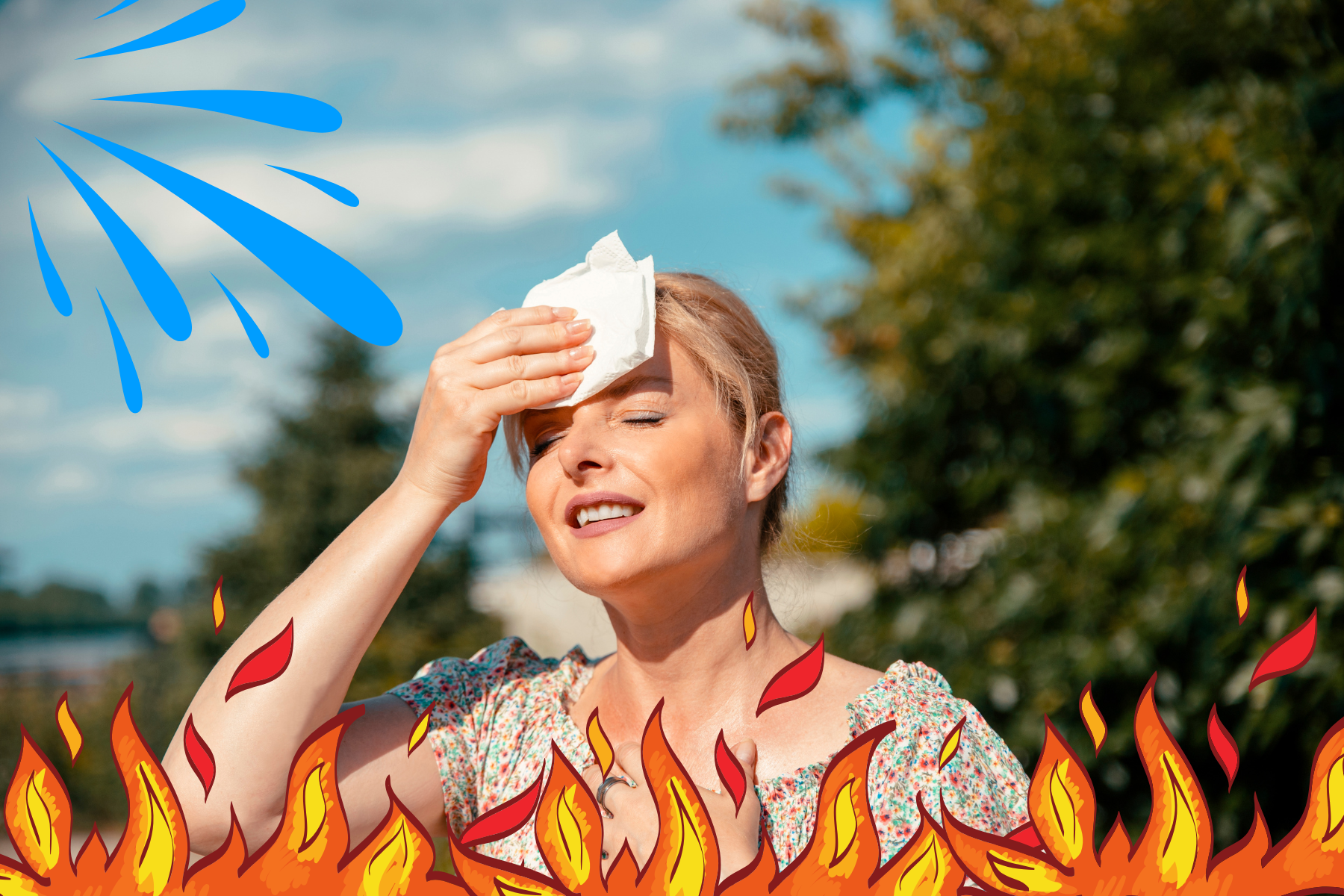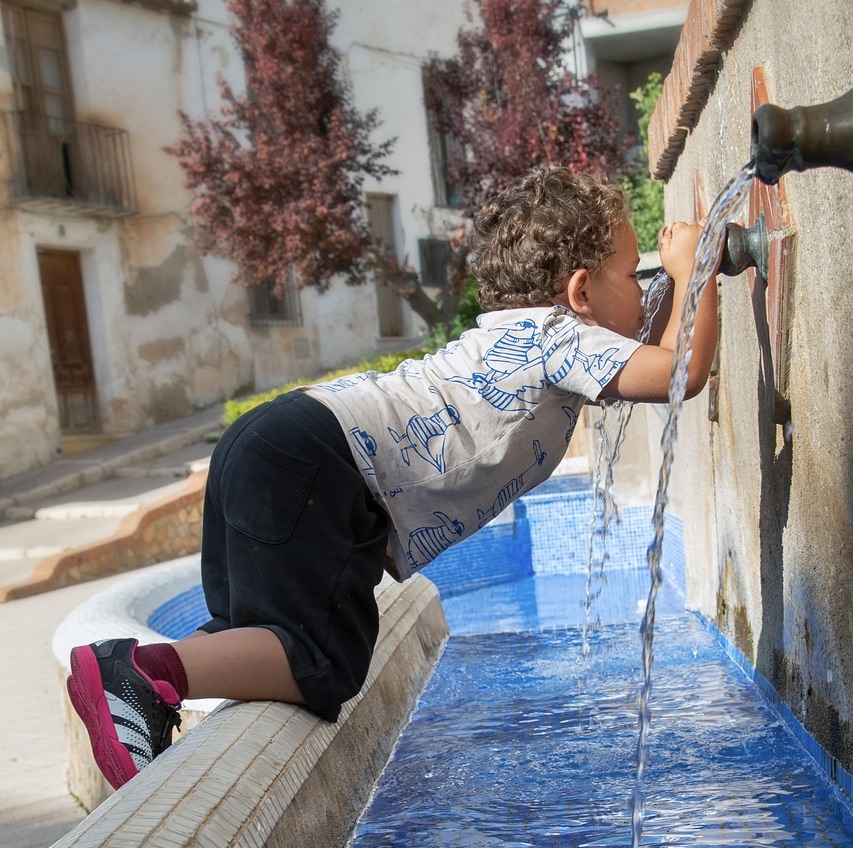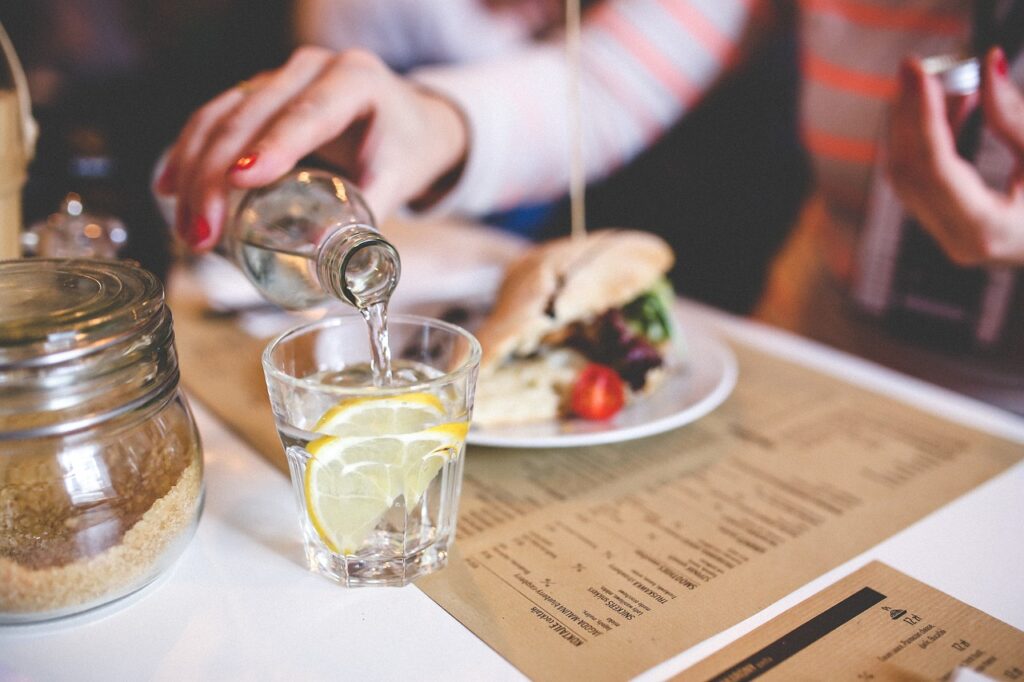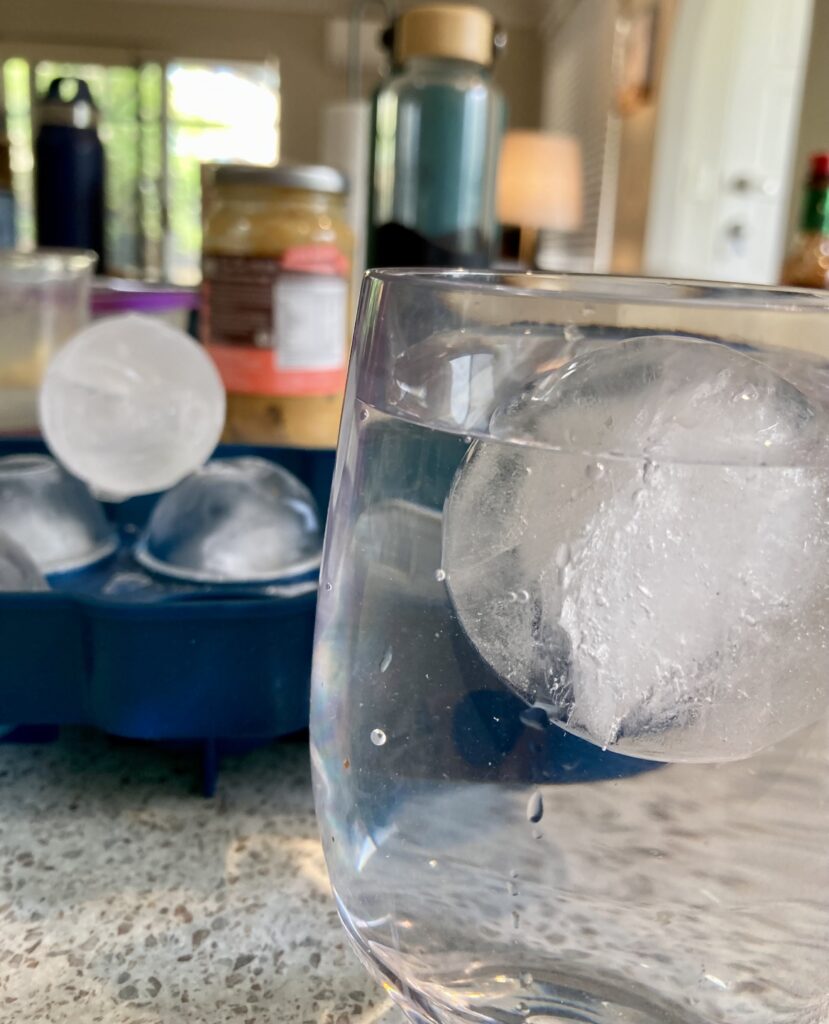
If you’re reading this article to learn about hydrating tips for hot flash relief, chances are that you know hot flashes can feel like your body’s own personal fireworks show, except not in a fun way. One minute you’re fine, and the next, you’re peeling off layers, fanning yourself, and wondering if you’re going to turn into the human torch.
The first thing I must acknowledge is that my friends here in Australia call them hot flushes. I tend to default to hot flash, because of prior programming, but hot flush is equally descriptive. However, I would argue that neither term describes the igniting furnace from within adequately,.
What is actually happening inside with a hot flush / flalsh? Basically, your hypothalamus, your body’s temperature regulating system, is triggered by hormonal changes during menopause to go haywire!
During a hot flash, there’s a sudden surge of heat that spreads through your chest, neck, and face, often accompanied by sweating and a rapid heartbeat. It’s your body’s response to its thermostat being set too high, causing a quick cool-off method through dilated blood vessels.
The Good News?
There’s a simple, natural way to help manage those unpredictable hot flush temperature surges—hydration! Following the hydration tips in this article can help you find hot flash relief.
While we often think about water for energy and glowing skin, staying well-hydrated is also a game-changer for managing hot flashes, regulating body temperature, and keeping your hormones happy.
Let’s dive into why hydration matters and how you can optimize your fluid intake to stay cool, comfortable, and in control.
When your body’s heat management system kicks into overdrive, fluids get lost faster due to sweating. This makes keeping up with water intake essential to help your body chill out—and I mean that literally!
Identifying triggers and symptoms is a great starting point. It could be spicy food, caffeine, stress, alcohol, or even a hot room. And the symptoms? Apart from the heat wave, some women might experience dizziness or feelings of anxiety. Knowing these can help you anticipate and manage them better.
Hydration Levels and Your Cycle
Hydrating tips for hot flashes isn’t just about quenching thirst, it’s about bolstering up your body’s silent partner in handling those pesky hot flashes. Men and Premenopausal women are about 60-70% water, and every single system relies on it to function properly. As estrogen levels decline during perimenopause, your body’s ability to regulate temperature becomes less efficient, making hot flashes and night sweats more intense. On top of it, our percentage of body water content begins to decline through perimenopause and drops to about 55% in postmenopausal women.
Additionally, perimenopausal women who are still having their cycle may tend to bloat during the luteal phase. Storing more water in the tissues, means having even less water circulating in your bloodstream to cool you down.
The Role of Hydration in Alleviating Hot Flashes
Proper hydration helps your body manage its internal thermostat more effectively, making those sudden auto combustions a bit more bearable.
Dehydration can make hot flashes feel even more intense, adding another layer of discomfort. Dehydration can also worsen symptoms like dry skin, muscle tension and soreness, mood swings, brain fog, energy crashes and tension headaches.
There’s a science behind it: when you’re dehydrated, your blood volume drops, and this makes your heart’s job tougher, pumping harder, as it tries to cool you down, leading to more pronounced symptoms.
Staying well-hydrated can actually help reduce the frequency and severity of hot flashes. Women who’ve upped their water game often report feeling more comfortable and balanced, even during the hottest moments.
Personal stories from women dealing with hot flashes echo the numbers. Many have found solace in sipping cold water—or their favorite herbal teas—throughout the day, enriching their body with steady hydration that smoothes over intense episodes.
My Top Hydrating Tips for Hot Flash Relief
If you’re not drinking enough fluids, your body has to work harder to keep you cool, which can intensify hot flashes. Making hydration a priority is a simple but effective way to support your body through menopause. Two easy tips to remember is to sip early and often rather than waiting to feel thirsty and relying on playing catchup by chuggling half a liter at once, which, by all means do if you are feeling thirsty! Second, drink while you are moving and during breaks in your workout. Take a water bottle with you on walks and outings for convenience.
Your Ultimate Drink Guide For Hot Flash Relief:
Not all drinks are created equal. Some will help you stay hydrated and regulate your body temperature, while others can make symptoms worse. Finding the right balance is key when it comes to water intake for taming hot flashes. Aim for at least 8 to 10 glasses a day, but listen to your body—it might need more, especially on hotter days or after workouts.
When it comes to drinks, water is the go-to, but if you don’t like it plain, you can infuse your water by adding slices of cucumber, lemon, berries, or mint!
Herbal teas such as peppermint, chamomile, or hibiscus tea offer cooling and calming effects that can also offer variety and relaxation.
Don’t forget about electrolytes – minerals like potassium and sodium help maintain fluid balance if you find you are experiencing a lot of night sweats. But go easy on the sports drinks! I’ll explain why in the next section below. If you’re sweating out in the intense heat or putting in long endurance training sessions, you can get the electrolytes you need by simply adding a pinch of salt and a little bit of maple syrup to your water.
If that doesn’t do it for you, consider Coconut water as pallatable alternative to water and is a less sugary electrolyte replacement than typical sports drinks.
And finally bone broth is great for hydration and joint health because it is rich in collagen and minerals.
Another option is to Incorporate water-rich foods into your meals to help quench your thirst. Some foods that come quickly to mind are; celery, cucumbers, oranges, spinach, strawberries, and watermelon. Not only do these foods contribute to your daily fluid goals, but they also pack vitamins that are great for your overall health.
Dehydrating Liquids and Foods to Avoid For Hot Flash Relief
Some liquids and foods can exacerbate your symptoms by messing with your hydration balance and even your gut function. Tracking what you eat may help you sort out what could be contributing to hot flashes or other perimenopausal symptoms.
Caffeinated Drinks such as coffee, black tea, and energy drinks can raise body temperature and increase sweating. Excess caffeine in your system can also keep you awake at night, causing fatigue which also contributes to hot flashes.
Alcohol makes you dehydrated, tired, shuts down fat burning, and stokes the flame of hot flashes. It acts as a diuretic directly depleting your hydration levels. Alcohol also effectively stops your liver’s removal of excess estrogens and halts fat burning to prioritize removing the poison from your system. Alcohol also wreaks your sleep by keeping you from reaching deep sleep.
Sugary Drinks such as soda, sweetened juices, many sports drinks, and flavored lattes cause a roller coaster of quick sugar spikes and crashes making it hard to regulate blood sugar which will stoke the fire of your hot flashes and leaves you feeling sluggish and hangry. I’m not saying that you can’t eat sugar at all, but pay attention to where you are getting added sugars and be selective.
Plus, Many sports drinks that are typically found on the grocery store shelves often contain high fructose corn syrup and maltodextrin which can be hard to digest, upset your stomach, and dehydrate you even more.
Incorporating Hydration into Your Daily Routine
Incorporating these top hydrating tips for hot flash hot flash relief can sometimes feel like a challenge, but it’s all about making your hydrating habits a part of your daily rhythm.
Start simple by keeping a bottle of water within arm’s reach. Pick a bottle that brings you a little joy and makes you happy to have with you whether you’re at home or on the go. Personally, I have an ice mold that makes 6 frozen balls of ice. For some silly reason, having frozen spheres of ice in my water brings me great joy!
To add to that joy, I recently acquired the perfect insulated water bottle. It’s stainless steel, has a durable lid that won’t break within a year, and has an opening wide enough that I can load up as many ifrozen ice balls as my heart desires! I have cold refreshing water on demand anytime I like. Life is good!
But let’s get back on track with your hydration…
Tracking your intake is another handy trick—there are plenty of apps that can remind you to sip throughout the day. Look for one that you can connect to your apple watch or activity tracker and have it send drinking reminders directly to your wrist.
Old-school methods like using a water bottle with time markers can keep you on track. Are you into gadgets? Get a Smart water bottle that flashes or beeps when it’s time to drink. That will make meeting your hydration goals almost impossible to ignore!
Stack your habits to remind yourself to drink while doing something else. Drink a glass of water first thing when you wake up in the morning. Drink water after every bathroom break. Have a glass before each meal. Sip in between sets at the gym and while you’re walking.
Remember to adapt to different seasons too. You might need a bit more hydration when it’s blazing hot or when you’re bundling up in dry, heated indoor air during winter.
Your Personalized Hydration Plan For Hot Flash Relief
Every woman’s hydration needs are different, so let’s create a plan that works for you:
- Find Your Baseline – Start with 8-10 glasses per day, then adjust based on your activity level and climate.
- Discover Your Favorite Hydration Hacks – Experiment with different drinks and foods to find what keeps you feeling your best.
- Track Your Hydration Levels – Clear or light yellow urine means you’re hydrated. Dark yellow or feeling fatigued? Time to drink up.
- Plan Ahead – Always have a reusable water bottle on hand. Traveling? Pack electrolyte packets.
- Adjust as Needed – Pay attention to how your body responds and tweak hydration habits as needed.
Beyond Hydration: Lifestyle Tweaks That Bring Hot Flash Relief
While staying hydrated is vital, tuning into other lifestyle tweaks can make a world of difference for getting hot flash relief. Start by checking your diet. Focus on whole, unprocessed foods, and steer clear of spicy dishes if you find they trigger episodes.
Mixing some moderate exercise into your weekly routine also helps. It keeps your body in harmony and can actually ease hot flash severity. Think about gentle activities like yoga or walking, which boost well-being without overheating. For other ideas check out my articles Managing Stress With Movement and Exercises To Do While Wallking.
Stress has a way of amplifying hot flashes, so finding strategies that help you unwind is crucial. Techniques like meditation, deep breathing, or even having a laugh with friends can lighten the load.
Remember, sleep plays its part, too. Making sure you catch enough z’s can help keep your body’s systems ticking along nicely. A good night’s rest aids in overall hydration and helps invigorate your body for the next day.
Pre-Bedtime Hydrating Tips for Hot Flash Relief
Disturbed sleep is a perfect cauldron for stirring up hot flashes. I know it’s not always in your control, but do everything you can to give yourself the opportunity to get good quality sleep.
- Drink earlier in the evening to avoid nighttime wake-ups.
- Try a small cup of warm herbal tea (like chamomile) to promote relaxation.
- Keep a glass of water by your bedside for easy sipping if you wake up hot.
- Use a cooling pillow or breathable bedding to minimize overheating.
Final Hydrating Tips For Hot Flash Relief
Managing hot flashes can be multi-layered. Making small, daily changes—like choosing the right fluids, avoiding dehydrating drinks, and building hydration-friendly habits—can make a huge difference in how you feel. Your body is working hard for you, so give it the support it needs with proper hydration.
Want a refreshing way to stay cool and support your body during menopause? Download our Happy Hydrating Guide & Thirst Quenching Recipes for delicious, hormone-friendly drinks that help keep hot flashes at bay and hydration levels high!
Thank you for visiting and reading my blog. I’d love to hear about your experience managing the inner flames, please share your thoughts in the comments.
Cheers!
Tammy




4 replies to "Hydrating Tips For Hot Flash Relief"
Hi there,
This was such an insightful read! I had no idea dehydration could make hot flashes even worse. You mentioned electrolytes—do you think sports drinks are a good option, or are they too sugary? Also, do you have any recommendations for someone who struggles to drink enough water throughout the day? I’d love to hear your thoughts! Thanks a lot!
Hi Daniella,
I’m glad you enjoyed the article. If you’re eating a balanced whole food diet with a normal amount of daily activity, you probably don’t need to worry too much about supplementing with electroytes. You do want to consider electrolytes if you are endurance training, out in the heat for long periods of time, or sweating alot.
Sports drinks may be high in electrolytes, but a lot of them also contain high fructose corn syrup and maltodextrin which counterintuitively can add to dehydration because the stomach needs to dilute the concentrated fructose with water to allow gastric emptying. If there isn’t enough water, the small intestines will draw water back to aid digestion. High fructose corn syrup is also hard for women to digest and can contribute to stomach upset.
Another option for electrolyte soluutions is to look for mixture with the proper osmalality. You could also do a simple solution of 16 oz water, 1 tsp maple syrup and 1/16th tsp salt. Dr. Stacy Sims is my go to authority for this. Here is an article on the subject. https://www.triathlete.com/nutrition/ask-stacy-why-is-hydration-so-important-for-triathletes/
Personally, I love drinking water. But if you don’t, try dressing it up with infusions, drinking non sugary and caffeine free drinks. Also, consume thirst quenching foods.
Hope it helps!
Tammy
That was such a well-rounded and insightful read! I really appreciate how you broke down the science behind hot flashes in such a relatable way comparing them to a personal fireworks show is spot on! It’s fascinating (and slightly frustrating) how the hypothalamus can misfire due to hormonal shifts, turning our body’s thermostat into a rollercoaster.
I love that you emphasized hydration as a natural and simple solution. People often overlook the impact of water beyond just quenching thirst, but it’s amazing how staying hydrated can regulate body temperature, balance hormones, and even minimize the intensity of hot flashes. The connection between declining estrogen levels and the body’s water retention shifts was particularly eye-opening.
One thing I was curious about—have you come across any research on whether electrolyte-rich drinks, like coconut water, are more effective at managing hot flashes than just plain water? Would love to hear your thoughts! 😊
Hi Kavitha,
I’m glad you found “Hydrating For Hot Flashes” helpful!
One thing to keep in mind regarding electrolyte drinks is that a roller coaster of blood sugar spikes will also trigger hot flashes, so you want to pay attention to where and how you are getting sugar in your diet. For women who don’t like drinking plain water, coconut water and electrolyte drinks may provide a more palatable option, but be aware that the added sugars may also contribute to peri and post menopausal symtpoms like hot flashes. For most women consuming a nutritionally dense balanced whole food diet, electrolyte drinks are not necessary to get adequate amounts of sodium and potassium.